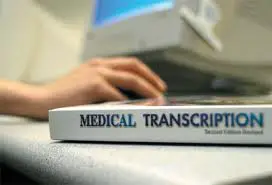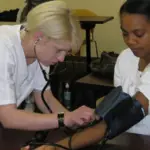Medical transcription certification is a professional credential that demonstrates a person’s knowledge and skills in transcribing medical reports and documents from spoken recordings made by healthcare providers. Medical transcriptionists are responsible for transcribing medical dictation accurately and in a timely manner, which requires a thorough understanding of medical terminology, anatomy, and pharmacology, as well as the ability to use specialized transcription software and equipment.
To get medical transcription certification, individuals typically need to meet certain education and experience requirements, and pass a certification exam. There are several organizations that offer medical transcription certification, such as the Association for Healthcare Documentation Integrity (AHDI) and the National Healthcareer Association (NHA). The specific requirements for certification may vary by organization, but generally, candidates must have completed a medical transcription training program and have a certain number of hours of work experience in the field.
Obtaining medical transcription certification can be beneficial for those seeking employment or advancement in the field, as it demonstrates a level of expertise and professionalism to potential employers. It can also help medical transcriptionists stay up-to-date on best practices and industry standards, and may be required for certain job positions or for continuing education requirements.
What is Medical Transcription Training?
Medical transcription training programs are designed to teach students the skills and knowledge needed to transcribe medical reports and documents from spoken recordings made by healthcare providers. These programs typically cover a wide range of topics, including medical terminology, anatomy, pharmacology, and transcription software and equipment. This Training is required for medical transcription certification.
Medical transcription training programs may be offered at vocational schools, community colleges, or online institutions, and can vary in length from a few months to a year or more. Some programs may offer both online and in-person courses, while others may be entirely online.
In order to enroll in a medical transcription training program, individuals typically need to have a high school diploma or equivalent. Some programs may also have prerequisites in subjects such as biology or English.
Upon completion of a medical transcription training program, students may be eligible to take a medical transcription certification exam offered by a professional organization, such as the Association for Healthcare Documentation Integrity (AHDI) or the National Healthcareer Association (NHA). Obtaining certification can be beneficial for those seeking employment or advancement in the field, as it demonstrates a level of expertise and professionalism to potential employers.
7 Tips to find Best Online Training for Medical Transcription Certification
- Determine your goals: Before you begin searching for an online medical transcription training program, it is important to determine your goals and what you hope to achieve through the program. This will help you narrow down your options and choose a program that is well-suited to your needs.
- Research accredited institutions: Look for online medical transcription training programs that are offered by accredited institutions. Accreditation is a process that ensures that a program meets certain standards of quality and has been evaluated by a recognized accrediting body.
- Consider the program format: Choose an online medical transcription training program that fits your learning style and schedule. Some programs may be self-paced and allow you to complete coursework at your own speed, while others may have set schedules and deadlines.
- Check for flexibility: Look for an online medical transcription training program that offers flexibility in terms of course delivery, such as the ability to access course materials and lectures online, and the option to attend live or recorded webinars.
- Review the curriculum: Research the curriculum of different online medical transcription training programs to ensure that they cover the topics you need to learn in order to be successful in the field. The program should cover medical terminology, anatomy, pharmacology, and transcription software and equipment.
- Consider cost: Compare the costs of different online medical transcription training programs to find the option that best fits your budget. Keep in mind that the cost of a program may vary based on its length, format, and any additional fees for materials or clinical experience components.
- Look for support: Choose an online medical transcription training program that offers support for students, such as access to academic advisors or tutors, and opportunities for networking and professional development.
How to get medical transcription certification?
To get medical transcription certification, you will typically need to meet certain education and experience requirements and pass a certification exam. The specific requirements for certification may vary by organization, but here are some general steps to follow:
- Complete a medical transcription training program: Many organizations that offer medical transcription certification require applicants to have completed a medical transcription training program. These programs are typically offered at vocational schools, community colleges, or online institutions, and may vary in length from a few months to a year or more.
- Gain work experience: Some organizations may require candidates to have a certain number of hours of work experience in medical transcription before they are eligible to take the certification exam. This requirement may vary by organization and can typically be met through internships, part-time or full-time employment, or volunteering.
- Meet any additional requirements: Some organizations may have additional requirements for certification, such as a certain level of education or the completion of certain courses. It is important to check with the specific organization to determine all requirements for certification.
- Register for the certification exam: Once you have met the necessary requirements, you can register for the certification exam with the organization of your choice. The exam may be offered online or in person, and may consist of multiple-choice questions or a transcription test.
- Pass the certification exam: In order to receive medical transcription certification, you will need to pass the certification exam. The exam may be graded on a pass/fail basis, or you may need to achieve a certain score to pass.
- Maintain your certification: Some organizations may require you to renew your certification every few years by completing continuing education courses or meeting other requirements. It is important to check with the organization that issued your certification to ensure that you are meeting all requirements for renewal.
How to get Online medical transcription certification?
To get online medical transcription certification, you will typically need to follow the same steps as you would to get medical transcription certification in a traditional setting, with some differences due to the online format. Here are some general steps to follow:
- Find an online medical transcription training program: There are a number of online institutions that offer medical transcription training programs. These programs may be entirely online or may combine online courses with in-person clinical experience or internships.
- Meet any admission requirements: In order to enroll in an online medical transcription training program, you will typically need to have a high school diploma or equivalent and meet any other admission requirements set by the institution. Some programs may have prerequisites in subjects such as biology or English.
- Complete the training program: Online medical transcription training programs typically cover a wide range of topics, including medical terminology, anatomy, pharmacology, and transcription software and equipment. You will need to complete all required coursework and any clinical or practical experience components of the program in order to graduate.
- Gain work experience: Some organizations that offer medical transcription certification may require candidates to have a certain number of hours of work experience in the field before they are eligible to take the certification exam. This requirement may be met through internships, part-time or full-time employment, or volunteering.
- Meet any additional requirements: Some organizations may have additional requirements for certification, such as a certain level of education or the completion of certain courses. It is important to check with the specific organization to determine all requirements for certification.
- Register for the certification exam: Once you have met the necessary requirements, you can register for the certification exam with the organization of your choice. The exam may be offered online or in person, and may consist of multiple-choice questions or a transcription test.
- Pass the certification exam: In order to receive medical transcription certification, you will need to pass the certification exam. The exam may be graded on a pass/fail basis, or you may need to achieve a certain score to pass.
- Maintain your certification: Some organizations may require you to renew your certification every few years by completing continuing education courses or meeting other requirements. It is important to check with the organization that issued your certification to ensure that you are meeting all requirements for renewal.
How much does medical transcription training cost?
The cost of medical transcription training can vary widely depending on the institution and program you choose. Some factors that may affect the cost of training include the length of the program, whether it is offered online or in person, and whether it includes any clinical or practical experience components.
Here are some examples of the cost of medical transcription training programs:
- Online programs: Online medical transcription training programs may cost anywhere from a few hundred dollars to several thousand dollars, depending on the length and scope of the program. Some online programs may be self-paced and allow students to complete coursework at their own speed, while others may have set schedules and deadlines.
- In-person programs: In-person medical transcription training programs may be more expensive than online programs due to the cost of tuition and any additional fees for materials or clinical experience components. These programs may cost several thousand dollars or more, depending on the institution and program.
- Financial aid: Some institutions may offer financial aid options, such as grants, scholarships, or loans, to help students cover the cost of medical transcription training. It is worth checking with the institution to see if any financial aid options are available.
It is important to research and compare the costs of different medical transcription training programs to find the option that best fits your budget and needs. Also helps to guarantee medical transcription certification after completion of training program.
How much is medical transcription certification?
The cost of medical transcription certification can vary widely depending on the institution offering the certification and the specific requirements of the program. Some medical transcription certification programs may be offered for free or at a low cost by community colleges or vocational schools, while others may be more expensive and offered by private institutions or online schools.
In general, you can expect to pay between $500 and $1,500 for a medical transcription certification program. Some programs may also require additional fees for materials or textbooks, which can add to the overall cost.
It’s important to do your research and compare the costs and benefits of different medical transcription certification programs before making a decision. You may also want to consider factors such as the program’s accreditation and the job prospects for medical transcriptionists in your area when deciding which program is right for you.
How to update medical transcription certification?
If you already have a medical transcription certification and want to update it, there are a few options you can consider:
- Renew your certification: Many medical transcription certification programs have expiration dates, after which you will need to renew your certification in order to continue working in the field. The process for renewing your certification will depend on the specific program you completed and may involve completing additional coursework, paying a renewal fee, or both.
- Complete additional training: You may also choose to update your certification by completing additional training or coursework in medical transcription or a related field. This can help you stay up-to-date on new technologies and techniques, as well as give you the opportunity to learn new skills that can help you advance in your career.
- Pursue additional certification: If you want to expand your expertise in medical transcription or gain additional skills, you may consider pursuing additional certification in a related field. For example, you could become certified as a healthcare documentation specialist, which may require completing additional coursework and passing an exam.
It’s important to carefully research your options and consider the time and financial commitment required before deciding which approach is right for you.
How long does medical transcription training take?
The length of medical transcription training can vary depending on the program and institution you choose. Some programs may be completed in as little as a few months, while others may take a year or more to complete.
Here are some factors that may affect the length of medical transcription training:
- Program format: Medical transcription training programs may be offered in a variety of formats, including online, in-person, or a combination of both. Online programs may be self-paced, allowing students to complete coursework at their own speed, while in-person programs may have set schedules and deadlines.
- Program length: Medical transcription training programs may vary in length, with some programs lasting several months and others lasting a year or more. The length of the program will typically depend on the depth and scope of the coursework, as well as any clinical or practical experience components.
- Individual pace: The length of time it takes an individual student to complete medical transcription training will also depend on their pace of study and how quickly they are able to complete coursework and any clinical or practical experience components.
It is important to research and compare the lengths of different medical transcription training programs to find the option that best fits your schedule and needs.
Education and training can be obtained from certificate and associate programs which can last from 1 year to 2 years depending on the type of program one chooses to join. Those with busy schedule or with family and job responsibility can join the distance education program which will help them learn the theoretical aspects of the career through online means.
Certificate Program in Medical Transcription
The certificate program is the shortest option to enter the medical transcriptionist career as it will last from 8 months to a year. It includes the general education courses for medical transcribing and upon completion you will be able to produce medical reports and documents, reports on patient’s history and physical examination, discharge summaries and referral letters and other administrative works.
Normally the coursework includes medical terminology and ethics, transcribing equipment handling and troubleshooting, human anatomy and physiology, communication and administrative skills, word processing software and basic computer skills. Overall the coursework focuses on preparing the individual for the entry level positions in the medical field as a transcriptionist.
What are the requirements one needs to meet in order to apply for the program?
In order to apply for this program, the applications are required to meet the age limitations and educational prerequisites.
- They need to be at least 18 years of age and should posses a high school diploma or equivalent GED with satisfactory GPA.
- Further requirements include completing a criminal background check and a drug test.
- CPR certification and recent health report are additional requirements that may be asked by top institutions.

Associate Degree in Medical Transcription
Now, this program is much advance than the certificate program and can take up to two years to complete. In addition to the general education courses, the program also includes all the skills needed by a medical transcriptionist to stay competitive and demanding on the medical field. Upon completion of the program, students can transcribe dictation from physicians and other health care workers into a physical document which will be a part of patient’s medical record.
The courses are designed to train students to use various dictation methods including voice recognition software and digital recording devices. Normally coursework includes transcription technology, surgical transcription, health care law, pharmacology, dictation, human anatomy and physiology, medical office procedures, computer skills and medical terminology and ethics. Overall the program combines the keyboarding, grammar and listening skills with the knowledge of medical terminology to help produce physical reports on patient’s history and examination. Also helps you to get medical transcription certification easily.
What are the requirements one needs to meet in order to apply for the program?
- First is the age limitation, only those with at least 18 years of age will be eligible for the program.
- Second, they need to poses a high school diploma or an equivalent GED with grade C and better performance on fundamental English, basic computer skills and general office procedures.
- Some top colleges and universities require students to pass a keyboarding test prior to admission.
- Applicants need to complete a criminal background check and a drug test and should provide evidences showing that they are in good health and that they do not have any contagious diseases.
- CPR certification with excellent communication and listening skills are additional requirements for the program.
Distance Education Courses in Medical Transcription Training
Those who are unable to attain a full time campus based class due to their busy schedule can have the opportunity to join the classes via online medium from anywhere and at anytime. This type of online program is designed specifically for those with a job and family responsibility. The program will allow them to earn a diploma or associate degree in medical transcription from their own place and at their own pace.
However one needs to remember that the term online does not necessarily mean that the program is 100% online. It is only the didactic component of the course that is presented via online means such as online lectures, discussions, live chats and video streaming. This is the only part of the program that can be taken from anywhere and at anytime.
Since any medical training program is more practical based, the medical transcriptionist trainings as well demands enough clinical experiences. Therefore for the next component of the online program, students will have to visit a clinical setting or college facility where they will learn the practical trainings and skills from an experienced medical personal in a real life setting. In order to earn an educational degree one needs to complete both the training with satisfactory results.
Registered Medical Transcriptionists (RMT) Exam
The exam is voluntary and is based on the descriptions, competencies and curriculum stated by the AHDI (Association for Health-care Documentation Integrity). The RMT exam is designed to determine whether the candidate has the core knowledge and skills to practice medical transcription in a clinical setting.
In order to apply for the program, the candidates need to complete a training program from an AHDI approved institutions and should have less than 2 years of working experience as a medical transcriptionist.
The exam consists of a set of multiple choice questions and fill in the blank transcription against audio. Each of these assessments tests the skills and knowledge of a candidate and determines whether he has got the skills to be an effective medical transcriptionist.
There are two portion of the exam; the transcription performance portion and the practical portion. In the transcription performance portion, the candidates should apply their transcription skills and in the practical portion, they need to demonstrate the skills in a real life setting.
For more information about the exam and some free samples, you can download a guide from here.
http://www.ahdionline.org/portals/0/downloads/CredentialingCandidateGuide.pdf
Certified Medical Transcriptionist (CMT) Exam
Certification after earning a diploma or associate degree in medical transcription is not compulsory but it has been found that most of the employers and the hospitals like to hire those with a state approved certificate. So for job security and to stay competitive in the job market, it is recommended to take the CMT exam and get approved by the state.
The exam is based on the curriculums, competencies and descriptions, stated by the AHDI (Association for Healthcare Documentation Integrity) and is designed to determine whether the candidate has the core knowledge and skills needed to practice medical transcription effectively in a facility that demands advanced level of clinical and interpretive ability.
Only the Registered Medical Transcriptionist with at least 2 years of experience in acute care transcription or a multispecialty equivalent will be eligible to take the exam. So first you need to pass the RMT exam.
The exam consists of 120 questions that includes fill in the blanks against audio, SRT against audio and multiple choice questions to test candidate skills, knowledge and judgment to practice medical transcription effectively in a clinical setting. The clinical portion of the exam emphasizes on the critical thinking and other technical skills; not only the keyboarding.
For more information about the exam and some free samples, you can download a guide from here.
http://www.ahdionline.org/portals/0/downloads/CredentialingCandidateGuide.pdf
Bottom Line
Medical transcriptionist can be a rewarding career for those interested in public health in these hard economic crises. Since the training does not last for long, the cost as well is far lower than in other training programs. Getting approved by the state although is not mandatory, will open new doors of opportunities in your career securing your job and increasing your salary so it is recommended to get a certification from AHDI.
It is equally important stay updated with the latest news and technologies in the medical field. The certification you will get from AHDI will be for a limited time interval and after expiration it will not have any value. So before the expiry date, apply for the recertification and renew the date.









